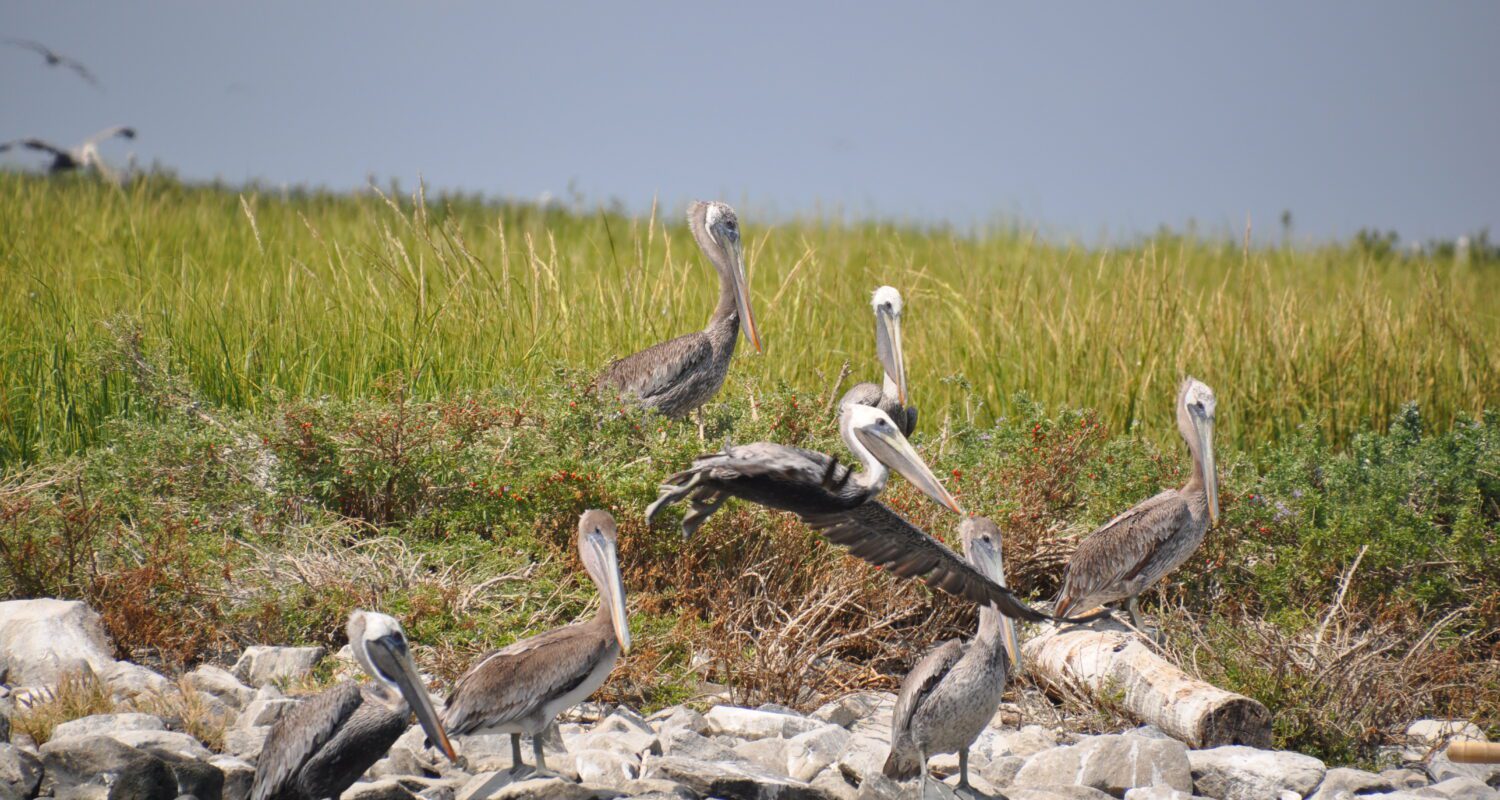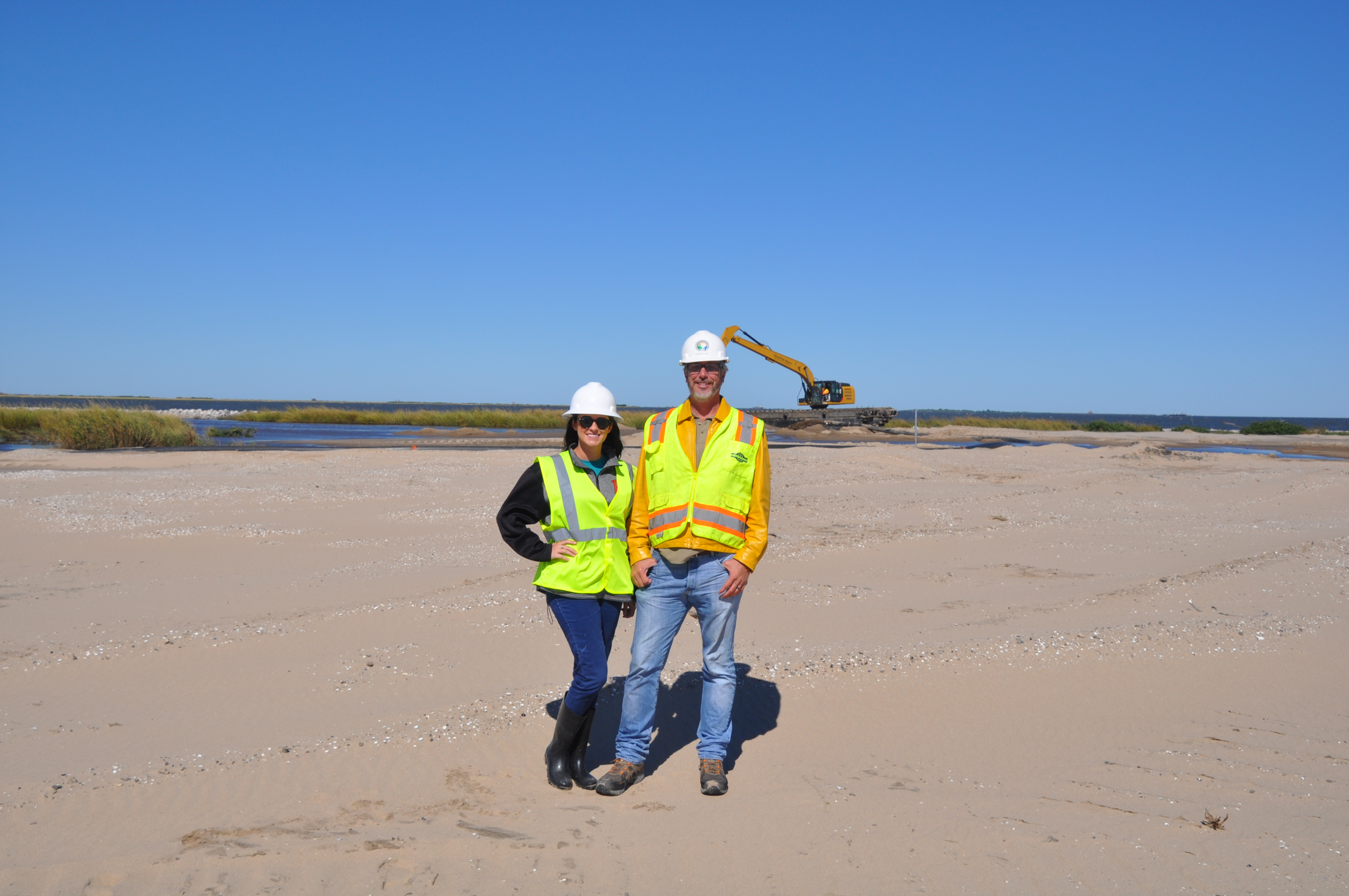 Menu
Menu
- Fenstermaker Insights
- Environmental
- The Bird Nerd


As Louisianans, we all know our state bird is the pelican, more specifically the brown pelican. Pelicans are used on many icons and symbols that represent Louisiana. A mama pelican, with outspread wings, feeding her young is displayed on the Louisiana State flag. The pelican is also found on the state seal, official state painting, the seals of state colleges, and the official state quarter. Louisiana even has an NBA team dubbed “The New Orleans Pelicans” where the chest of rookie, Zion Williamson adorns the logo containing a pelican carrying a basketball. Louisiana is known as “The Pelican State” and the reasons are obvious.
The nurturing ways of pelicans toward their young and the abundance of brown pelicans found along the coast may have been reasons that the pelican has represented Louisiana since 1966. Ever evolving coastal processes, oil and gas catastrophes, environmental contamination, and pesticides all contribute to the fact that abundance is not always promised. The disastrous 2010 Deepwater Horizon (DWH) oil spill is a prime example. Brown pelican bird mortality and additional fledglings not produced due to the mortality were estimated to exceed 9,000 birds in the State of Louisiana. Following the oil spill, a programmatic restoration plan to restore the impacts that occurred from the spill was developed. One of these goals was to restore and conserve habitats. Projects that would provide the most immediate benefit to the same Louisiana coastal habitats that were impacted by the DWH oil spill were identified. One of those projects was the Queen Bess Island Restoration Project (BA-0202). Fenstermaker was selected as the prime consultant for engineering and design.
Let’s first start with some history—Queen Bess Island is a barrier island located in Jefferson Parish, within Barataria Bay, and it is one of the largest and most productive breeding colonies in Louisiana for a number of colonial nesting bird species, including brown pelicans. Historically, the brown pelican habitat occurred throughout coastal Louisiana and estimates of the original pelican population were between 75,000 and 85,000; however, the brown pelican was virtually extinct in Louisiana by 1962 and the species was placed on the Federal Endangered Species List in 1970. The primary reason attributed for severe declines in the brown pelican population in the United States was dichlorodiphenyltrichloroethane (DDT) contamination in the 1960s and early 1970s. The Environmental Protection Agency (EPA) banned the use of DDT in the United States in 1972. From 1968 to 1980, the Louisiana Department of Wildlife and Fisheries and Florida Game and Fresh Water Fish Commission reintroduced 1,276 pelicans from Florida to three release sites in southeastern Louisiana. One of these sites included Queen Bess Island. A total of 2,751 pelicans were fledged by this colony during the 1971-1984 period. To continue providing suitable pelican habitat, three restoration projects on Queen Bess Island from 1990 to 1996 followed. These projects did little to increase the habitat for colonial waterbirds because most of the area created by these projects did not maintain an elevation suitable for use as nesting habitat. This was an important example of what our team did not want to do for BA-0202.
For the Queen Bess Project, conceptual goals and objectives were loosely created by the Louisiana Trustee Implementation Group (TIG) in the Final Restoration Plan (RP), which included restoring the island’s suitable colonial waterbird nesting and brood-rearing habitat from its current size of less than 5 acres to its historical peak of approximately 36 acres. While the primary project goal of increasing brown pelican, tern, black skimmer and other colonial waterbird habitat was well defined, it was acknowledged that the RP was conceptual in its design components. Fenstermaker was tasked with refining the engineering and design goals and associated objectives. To do so, bird habitat knowledge was crucial.
T he Fenstermaker Team knew what a brown pelican looked like; we’ve seen them in places along the coast; some knew what they liked to forage on; and one knew what their nests looked like, but none of us knew what elevation they prefer to nest at, what type of vegetation, the density of vegetation, and the type of ground material they liked to nest on, much less these same factors for the other birds—terns and black skimmers. I didn’t even know what a tern or a black skimmer looked like. We had a lot to figure out. First, I should probably know what these birds look like. The black skimmer, a small black bird, having a white chest with a long orange and black beak. OK—got it!
he Fenstermaker Team knew what a brown pelican looked like; we’ve seen them in places along the coast; some knew what they liked to forage on; and one knew what their nests looked like, but none of us knew what elevation they prefer to nest at, what type of vegetation, the density of vegetation, and the type of ground material they liked to nest on, much less these same factors for the other birds—terns and black skimmers. I didn’t even know what a tern or a black skimmer looked like. We had a lot to figure out. First, I should probably know what these birds look like. The black skimmer, a small black bird, having a white chest with a long orange and black beak. OK—got it!
The tern, oh wait, there are at least seventeen types of terns in North America. What types of terns were we trying to bring to Queen Bess Island? Generally, they looked like a sea gull you commonly see on vacations to Florida. I learned that they may look similar, but you can tell them apart by the terns s traight, sharp beak compared to gulls’ curved beak. Ok, back to figuring out what types of terns we wanted at Queen Bess. Louisiana Department of Wildlife and Fisheries (LDWF) “Birds of Louisiana List” narrowed us down to eleven tern species and research articles further put us at seven tern species that are known to nest in Louisiana on a regular basis. How am I supposed to know where exactly these birds are nesting in Louisiana? Research told me that Forster’s terns like to nest in marsh, and royal terns liked to nest on beaches; some terns use artificial islands, and some don’t; sooty terns’ nests are usually located beneath shrub, but least terns commonly nest in bare sand and shell; gull-billed terns’ nests are frequently found in sites lacking vegetation, and some terns prefer strictly vegetated areas.
traight, sharp beak compared to gulls’ curved beak. Ok, back to figuring out what types of terns we wanted at Queen Bess. Louisiana Department of Wildlife and Fisheries (LDWF) “Birds of Louisiana List” narrowed us down to eleven tern species and research articles further put us at seven tern species that are known to nest in Louisiana on a regular basis. How am I supposed to know where exactly these birds are nesting in Louisiana? Research told me that Forster’s terns like to nest in marsh, and royal terns liked to nest on beaches; some terns use artificial islands, and some don’t; sooty terns’ nests are usually located beneath shrub, but least terns commonly nest in bare sand and shell; gull-billed terns’ nests are frequently found in sites lacking vegetation, and some terns prefer strictly vegetated areas.
Thanks to the researchers, bird enthusiasts, LDWF, and all others who have knowledge on types of birds, where they nest, and all that jazz—sandwich terns and royal terns were the only documented tern species to nest on Queen Bess Island and least terns were documented at Grand Terre Islands, which neighbors Queen Bess. I also learned that black skimmers were documented on Queen Bess Island, and research proves that least terns, gull-billed terns, and black skimmers commonly nest amongst one another. So, we had a start—sandwich terns and royal terns are already there, black skimmers are too, and if we could provide the right habitat, least terns and gull-billed terns may be attracted to the island.
The next step was to identify the preferred habitat of these birds. I found that pelicans prefer to nest within trees or shrubs such as mangroves, lycium, groundsel bush, and marsh elder. They also like to be higher off the ground and elevations of their nesting habitat are significantly higher than elevations not being used by the pelicans. Ok, sounds like they like to be perched on bushes, so I guess we should plan to plant some of these species on the island. Terns like to nest on sand and shell substrate and often nest on the highest point of dredge islands. They prefer unvegetated, bare cover to moderate forbs. Side note—I learned what a forb is… a herbaceous flowering plant that is not a grass. Ok, sounds like we also need an unvegetated area on the island. Finally, black skimmers also prefer nesting on unvegetated areas, commonly on sand substrates, but most importantly, black skimmers like to nest among gull-billed terns and least terns, and they choose their nest site last, first among terns and then expanding to areas outside the tern colony as the nest sites become limited. Ok, sounds like if we can attract the terns, the skimmers will follow, and since terns prefer shell and sand substrate, we will need an area of sand and shell. To conclude, the design needed to encompass an area of vegetation for the pelicans and an area of sand and shell substrate with minimal vegetation for the terns and skimmers.
The team also had to consider ideal elevations so that Queen Bess could sustain coastal processes. You know—subsidence, erosion, weather events, wind and wave conditions, etc. We have to make this baby last; we do not want a repeat of the three prior projects constructed between 1990 and 1996.

So, let’s start with the pelicans—Queen Bess already had areas consisting of mangrove and plant species that pelicans prefer, but the team also knew these could get destroyed during construction, as bringing the island up to acceptable elevations was key. Our federal and state partners specifically requested mangroves. Oh, but wait, mangroves propagate in the intertidal elevation range (above water level at low tide and underwater at high tide). I thought—how is this even going to be possible; we have to increase the elevations of the island and protect the nests from the high water. The survey showed the area where the existing mangroves were already found was about 60% intertidal. The team decided to work with what was already successful (where the majority of pelicans were already nesting) with a bit of enhancement. Elevations near the higher end of intertidal range were chosen to allow for further mangrove vegetation to propagate. The team also proposed to fill the depression areas that were scattered throughout. We also planned for a planting operations and maintenance events in future years. The raised vegetation will reduce flood threat, and the vegetation is expected to grow and increase in coverage over time. The eggs and the babies will be in bushes, they’ll be good!
Next, the terns, and since the skimmers follow the terns, we designed for both. Remember, they prefer nesting on shell and sand material at higher elevations. This was opposite of the preference of the pelicans. So, one side of the island should be really high, and one side should be lower, ok. To do this, the team selected elevations above the 10% probability of exceedance for the life of the project, so the tern and skimmer eggs and babies would be protected. The team proposed this at the opposite side of the low area needed for the pelicans, so that they could be connected by sloping the material from the high side to the low side. It was also important that we provided an area of shell and sand substrate but finding shell substrate proved difficult. Through more research, I determined that small limestone similar to shell was also commonly used by terns, so we selected a #8 crushed limestone as a replacement.
They say millennials like to learn, and in my case a day (or weeks) of research and report writing means a successful day. I volunteered to do the bird research for Queen Bess, which encompassed a compilation of numerous research documents and reports, and eventually became the basis for the project, in a report titled Habitat of Various Waterbirds: Brown Pelicans, Terns, and Black Skimmers. Further, I was tasked with presenting these findings to our state and federal partners. And would you guess who would be in the room, the very people listed as authors on the reference page of the report. I had to present findings and suggest a design to people who studied birds for a living. Lucky for me, it was successful. And that is how I garnered the nickname “The Bird Nerd.”

Your company’s success is our business
Discover our industry-leading products and service that our customers have been trusting in for decades. Whatever your need, we’re here.